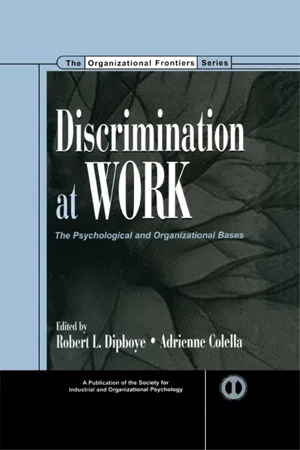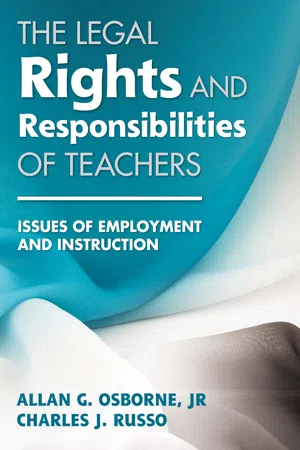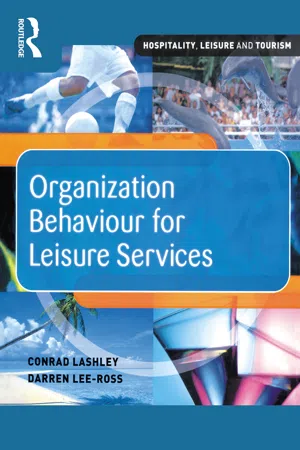Business
Discrimination in the Workplace
Discrimination in the workplace refers to the unfair treatment of employees based on characteristics such as race, gender, age, or disability. This can manifest in hiring, promotion, pay, or other employment decisions. It is illegal and unethical, and businesses are responsible for creating a work environment that is free from discrimination.
Written by Perlego with AI-assistance
Related key terms
7 Key excerpts on "Discrimination in the Workplace"
- eBook - ePub
The Dark Side of Organizational Behavior
Examining Undesirable Aspects of Organizational Life
- H. Cenk Sözen, H. Nejat Basım, H. Cenk Sözen, H. Nejat Basım(Authors)
- 2022(Publication Date)
- Routledge(Publisher)
4Discrimination at workEsra Aydın and H. Nejat BasımDOI: 10.4324/9781003292401-5Introduction
In today’s organizations, it is essential to be aware of and understand the diversities in the workplace, which may include race/color, gender, national origin, sexual orientation, age, pregnancy, disability, religion and genetic information. If diversities cannot be managed effectively, organizations may face the issue of discrimination. Discrimination, which means to treat people unfairly at work because of some categories they belong to or characteristics they have, is a crucial dark behavior in organizations that must be eliminated and controlled for effective and efficient management. This chapter provides a broad review of the concept of discrimination and its types at work with contemporary theory and practice. Moreover, the antecedents and possible consequences of discrimination will be explained in the framework of evidence in the literature. The main purpose of this chapter is to contribute to theory and present practical implications for managers and coworkers by explaining, reviewing and sharing recent findings on the concept of discrimination.Discrimination as a somber concept
Discrimination is a prevalent treatment that some people are exposed to not only in the organizational context but also in their daily lives. As it creates many problems in individuals’ psychological, social and physical conditions, it has always been an important research topic in many disciplines such as psychology, sociology, social psychology, education, political science, law, criminology and organizational studies. It is possible to give many definitions of discrimination with different scientific aspects. In this part, several definitions are given that contain different aspects of discrimination in social sciences. - eBook - ePub
Employment Claims without a Lawyer
A Handbook for Litigants in Person, Revised 2nd edition
- David Curwen(Author)
- 2020(Publication Date)
- Bath Publishing(Publisher)
Discrimination and victimisation applies not just to existing employees but also to persons applying for employment and applies in relation to the terms on which the employment is offered or by not offering employment (section 39 Equality Act 2010). Discrimination can apply to job advertisements as well as questions asked in job interviews.4.11 Discrimination in employment
Section 39 of the Equality Act 2010 sets out the different ways in which discrimination can occur in employment relationships. The Act specifically prohibits discrimination: • in the terms of employment; • in the way the employer gives to or withholds from employees access for promotion, transfer, training or receiving any other benefit, facility or service; • by dismissing the employee; or • by subjecting him to any other detriment.One of the defences open to employers when applying a requirement that the applicant or employee must have a particular protected characteristic, is that, having regard to the nature or context of the work, that protected characteristic is an occupational requirement. An example of this could be a job which involves searching female prisoners and is only open to female applicants. The application of the requirement must be a proportionate means of achieving a legitimate aim.4.12 Contract of service
The Equality Act applies to people who are employed under a contract of service, an apprenticeship or a contract to do work personally. This does not normally include people working as volunteers - nor does it apply to self-employed people.4.13 Vicarious liability
Where an employee, in the course of his employment, discriminates against another employee or against a job applicant this will be treated as an act of discrimination by the employer, even if the act is done without the employer’s knowledge or approval (section 109). The legal term for this is “vicarious liability”, where the employer is vicariously liable for the discrimination carried out by one of his employees in the course of his employment.The employer will have a defence if he can show that he took all reasonable steps to prevent the person from carrying out the act complained of. The sort of thing that a tribunal would want to see is that the employer had provided equality training and that it had a proper system for acknowledging and dealing with complaints of discrimination. If the tribunal considers that the employer could and should have done more to prevent the discrimination it will probably find that the employer has not made out its defence. - eBook - ePub
Discrimination at Work
The Psychological and Organizational Bases
- Robert L. Dipboye, Adrienne Colella, Robert L. Dipboye, Adrienne Colella(Authors)
- 2013(Publication Date)
- Psychology Press(Publisher)
In this chapter, we first summarize findings of gender bias in decisions and outcomes at work, followed by a description of the individual-based and situational antecedents involved in gender discrimination. We then introduce a broader discussion of discrimination and equality at the societal, institutional, and organizational levels drawing on a number of literatures including careers, sociology, economics, and work and family. By broadening the conceptualization of discrimination, we are able to identify some antecedent conditions that set the stage for discrimination, which we hope will encourage a more comprehensive consideration of the consequences of gender discrimination. Our broad definition of discrimination is followed by a brief description of the seriousness and pervasiveness of gender discrimination, which illustrates major gaps in existing research and important methodological issues for future consideration to research theorizing about gender discrimination. Finally, we conclude our chapter with a discussion of how organizations can be a tool for change and for activism in reducing gender discrimination.GENDER DISCRIMINATION IN WORK EXPERIENCES AND OUTCOMESWhat kinds of evidence exist for gender Discrimination in the Workplace? Traditional definitions of gender Discrimination in the Workplace emphasize legal approaches to sex discrimination. In the United States, two basic kinds of evidence define gender discrimination. The first, known as disparate treatment, occurs when individuals are intentionally treated differently by virtue of their group membership. Examples of disparate treatment include unwillingness to hire a woman because of her gender, reluctance to place a woman in career-track positions, asking a woman questions during an interview that are different from those asked of male applicants, and offering a lower starting salary because the recruit is a woman. A somewhat broader definition of gender discrimination (disparate impact) is represented by evidence that members of a particular group are adversely affected by the procedures used to make workplace decisions and by workplace practices. Even though these practices may not be intended to discriminate between men and women, they have the impact of providing proportionately fewer opportunities to women than to men. If job-related reasons (such as differences in job qualifications) cannot account for gender differences in outcomes, the most viable explanation for those differences is gender discrimination. - eBook - ePub
The Legal Rights and Responsibilities of Teachers
Issues of Employment and Instruction
- Allan G. Osborne, Charles Russo(Authors)
- 2011(Publication Date)
- Corwin(Publisher)
6ProhibitionsAgainstEmploymentDiscrimination
KEY CONCEPTS IN THIS CHAPTER- Racial, Ethnic, or National Origin Discrimination
- Religious Discrimination
- Gender Discrimination
- Disability Discrimination
- Age Discrimination
- Genetic Information
- Retaliation Claims
- Affirmative Action
INTRODUCTION
Discrimination can be defined as the unfair treatment or denial of normal privileges to individuals because of innate characteristics such as their race, sex, age, nationality, or religion. Discrimination occurs when people are treated unequally due to those characteristics. The Equal Protection Clause of the Fourteenth Amendment to the U.S. Constitution1 along with a variety of important federal and state statutes protect employees and applicants for public employment from discrimination based on factors such as race, color, ethnicity, national origin, religion, gender, age, and disability.Prohibitions against discrimination extend to any aspect of employment, including hiring, training, firing, layoffs, wages, fringe benefits, job assignments, promotions, and any other condition of employment. Various sections of the Civil Rights Act of 1964,2 particularly Title VII, provide many of these protections.The Civil Rights Act of 1964 was initially proposed by President John F. Kennedy but was signed into law by President Lyndon B. Johnson following Kennedy’s assassination. The most sweeping civil rights statute enacted since the Reconstruction period following the Civil War, the Civil Rights Act of 1964 prohibited discrimination in public places while mandating the integration of public facilities, including schools. While this statute addressed discrimination based on race, color, national origin, religion, and sex, later legislation makes it illegal to discriminate on the basis of other factors such as age, disability, and genetics. - eBook - ePub
Employment Law
The Essentials
- David Balaban Lewis, Malcolm Sargeant(Authors)
- 2019(Publication Date)
- CIPD - Kogan Page(Publisher)
06Discrimination against employees (1)
Chapter overview
In this chapter, we consider the Equality Act 2010, which sets out nine protected characteristics : age, disability, gender reassignment, marriage and civil partnership, pregnancy and maternity, race, religion or belief, sex and sexual orientation – in respect of which the Act gives protection against discrimination. We go on to consider the types of prohibited conduct : direct discrimination, discrimination arising from disability, gender reassignment discrimination, pregnancy and maternity discrimination, indirect discrimination, failure to make reasonable adjustments, harassment and victimisation. We conclude the chapter by noting that, as a general rule, discrimination is unlawful at all stages of employment.After studying this chapter you will be able to:LEARNING OUTCOMES
- understand and explain the legal principles that apply to the different types of discrimination, such as that on grounds of sex, race, religion or belief, etc
- advise colleagues on the employer’s role in, for example, ensuring that company rules and practices do not result in indirect discrimination, that reasonable adjustments are made for disabled employees and applicants, and on avoiding any discrimination in respect of pregnant employees or applicants – even in relation to a fixed-term contract.
6.1 Equality law
One of the aims of equality law1 is to protect certain groups of people who experience disadvantage and unequal treatment due to prejudice and stereotyping related to their characteristics. In relation to the workplace, UK equality law attempts to ensure that these people have the same opportunity as everyone else to obtain and retain work and to progress in their careers.The sources for equality law in the UK are the Equality Act 2010 as well as EU law in the form of treaty articles and secondary legislation (see Chapter 1 - eBook - ePub
- Darren Lee-Ross, Conrad Lashley(Authors)
- 2012(Publication Date)
- Routledge(Publisher)
Apart from these classic examples of discrimination based largely on appearance or religious beliefs or sexual orientation, some leisure service organization members are discriminated against because of trade union membership. Those employees who choose to join a trade union and request that the trade union represents them can face unfair and unequal treatment. Patterns of trade union membership in leisure service organizations varies among countries and sectors. In the UK, for example, trade union membership across leisure services tends to be low compared with the national average (Lucas, 1995). Some sectors have higher than average trade union membership, while others are very much below average. Membership tends to be higher in leisure centres, canteens and school meals, and low in hotels, restaurants and pubs. In Germany trade union membership tends to be higher across the service sector than in the UK and there is an important legislative framework to support employee rights in all organizations.Key point 11.2Discrimination at work can be directed at people who are different to those who exercise power in an organization. Prejudging people on the basis of stereotypes can present barriers to equality of opportunity and limit chances of progression and career advancement.Over recent years a number of factors have brought about increased concern that organizations address some of the discriminatory practices of the past:Reflective practice- What problems does discrimination cause for an organization
- List the reasons why organizations are increasingly concerned to promote equality of opportunity.
- Highlight some ways that an organization could monitor fair employment practice.
- Increased social awareness of the unfair treatment of people through discrimination has created a climate wherein firms are required to at least achieve some basic standards of social justice. Negative public relations effects are likely to ensue for a firm that is seen to practise discriminatory polices.
- As a result of pressure group influence, firms involved in unacceptable practices have been targeted for campaigns aimed at damaging the business – product boycotts, leaflet campaigns and adverse publicity campaigns have all been used.
- As a result of this increased public awareness and campaigns, governments across the world have introduced legislation that outlaws discrimination and requires organizations to practise equal opportunities.
- Firms have increasingly recognized the links between investment profile and employment practice. Firms wanting to be seen as a good business investment have built a profile of a ‘good practice’ employer. A sound equal opportunities policy has been one of the cornerstones of this ‘good employer’ model.
- eBook - ePub
Workplace Equality in Europe
The Role of Trade Unions
- Anna Paraskevopoulou, Sonia McKay(Authors)
- 2016(Publication Date)
- Routledge(Publisher)
Just as the Roma are identified as a group largely excluded from the labour market, so too are those with disabilities who also have lower employment participation rates compared to the rates for workers without disabilities. Disability experts argue that the data concerning disability is too unreliable to make accurate assessments of the extent of discrimination, but are agreed that there is endemic discrimination against those who are disabled. This may not be demonstrated in overt forms but in the ways in which society is structured so that the disabled often appear invisible in the public arena, as an expert reporting to the Mapping study noted:Disabled people are still at significant disadvantage in the labour market in all European countries … They have, in general, lower participation rates, higher levels of unemployment and a lower educational attainment level, than the rest of the population. Most countries pursue active strategies to include and integrate people with disabilities in the labour market. However the degree of success is not always measured or evaluated.Age discrimination in relation to recruitment and retention presents problems to Europe’s older workers, as AGE Europe notes:It is therefore clear that age is fast becoming the most commonly perceived disadvantage in the labour market. This strongly reflects the reality that is faced by many older workers, in particular older women, who are among those most affected by the crisis and one of the groups most likely to lose their job and be unable to find new employment (Age Platform Europe, 2013).One in six Eurobarometer respondents reported personal experience of discrimination, with those with a disability or belonging to a sexual or ethnic minority being likely to do so. One in three respondents had themselves witnessed or had heard of someone who had suffered discrimination in the previous year. This means that when addressing discrimination it is important to take account not just of those who may directly experience discrimination but also to recognise that discriminatory actions have a ripple effect. They create instability and uncertainty, particularly in employment, in those cases where discriminatory conduct is not successfully challenged.
Learn about this page
Index pages curate the most relevant extracts from our library of academic textbooks. They’ve been created using an in-house natural language model (NLM), each adding context and meaning to key research topics.






